air condition Seat Mii 2013 Owner's manual
[x] Cancel search | Manufacturer: SEAT, Model Year: 2013, Model line: Mii, Model: Seat Mii 2013Pages: 306, PDF Size: 4.3 MB
Page 5 of 306
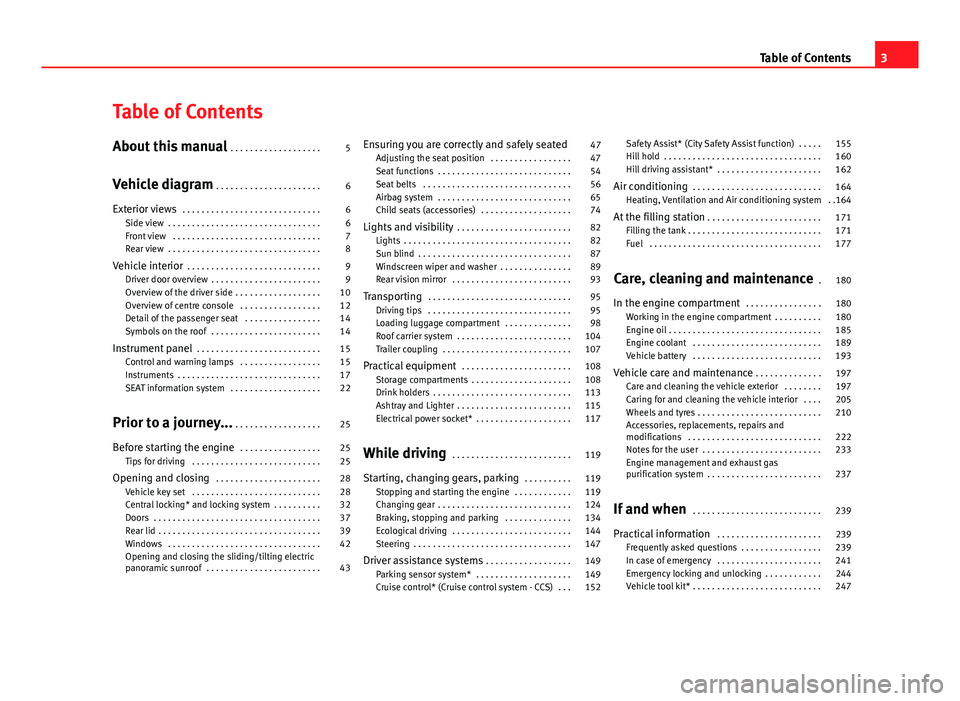
Table of Contents
About this manual . . . . . . . . . . . . . . . . . . . 5
Vehicle diagram . . . . . . . . . . . . . . . . . . . . . . 6
Exterior views . . . . . . . . . . . . . . . . . . . . . . . . . . . . . 6
Side view . . . . . . . . . . . . . . . . . . . . . . . . . . . . . . . . 6
Front view . . . . . . . . . . . . . . . . . . . . . . . . . . . . . . . 7
Rear view . . . . . . . . . . . . . . . . . . . . . . . . . . . . . . . . 8
Vehicle interior . . . . . . . . . . . . . . . . . . . . . . . . . . . . 9
Driver door overview . . . . . . . . . . . . . . . . . . . . . . . 9
Overview of the driver side . . . . . . . . . . . . . . . . . . 10
Overview of centre console . . . . . . . . . . . . . . . . . 12
Detail of the passenger seat . . . . . . . . . . . . . . . . 14
Symbols on the roof . . . . . . . . . . . . . . . . . . . . . . . 14
Instrument panel . . . . . . . . . . . . . . . . . . . . . . . . . . 15
Control and warning lamps . . . . . . . . . . . . . . . . . 15
Instruments . . . . . . . . . . . . . . . . . . . . . . . . . . . . . . 17
SEAT information system . . . . . . . . . . . . . . . . . . . 22
Prior to a journey... . . . . . . . . . . . . . . . . . . 25
Before starting the engine . . . . . . . . . . . . . . . . . 25
Tips for driving . . . . . . . . . . . . . . . . . . . . . . . . . . . 25
Opening and closing . . . . . . . . . . . . . . . . . . . . . . 28
Vehicle key set . . . . . . . . . . . . . . . . . . . . . . . . . . . 28
Central locking* and locking system . . . . . . . . . . 32
Doors . . . . . . . . . . . . . . . . . . . . . . . . . . . . . . . . . . . 37
Rear lid . . . . . . . . . . . . . . . . . . . . . . . . . . . . . . . . . . 39
Windows . . . . . . . . . . . . . . . . . . . . . . . . . . . . . . . . 42
Opening and closing the sliding/tilting electric
panoramic sunroof . . . . . . . . . . . . . . . . . . . . . . . . 43 Ensuring you are correctly and safely seated
47
Adjusting the seat position . . . . . . . . . . . . . . . . . 47
Seat functions . . . . . . . . . . . . . . . . . . . . . . . . . . . . 54
Seat belts . . . . . . . . . . . . . . . . . . . . . . . . . . . . . . . 56
Airbag system . . . . . . . . . . . . . . . . . . . . . . . . . . . . 65
Child seats (accessories) . . . . . . . . . . . . . . . . . . . 74
Lights and visibility . . . . . . . . . . . . . . . . . . . . . . . . 82
Lights . . . . . . . . . . . . . . . . . . . . . . . . . . . . . . . . . . . 82
Sun blind . . . . . . . . . . . . . . . . . . . . . . . . . . . . . . . . 87
Windscreen wiper and washer . . . . . . . . . . . . . . . 89
Rear vision mirror . . . . . . . . . . . . . . . . . . . . . . . . . 93
Transporting . . . . . . . . . . . . . . . . . . . . . . . . . . . . . . 95
Driving tips . . . . . . . . . . . . . . . . . . . . . . . . . . . . . . 95
Loading luggage compartment . . . . . . . . . . . . . . 98
Roof carrier system . . . . . . . . . . . . . . . . . . . . . . . . 104
Trailer coupling . . . . . . . . . . . . . . . . . . . . . . . . . . . 107
Practical equipment . . . . . . . . . . . . . . . . . . . . . . . 108
Storage compartments . . . . . . . . . . . . . . . . . . . . . 108
Drink holders . . . . . . . . . . . . . . . . . . . . . . . . . . . . . 113
Ashtray and Lighter . . . . . . . . . . . . . . . . . . . . . . . . 115
Electrical power socket* . . . . . . . . . . . . . . . . . . . . 117
While driving . . . . . . . . . . . . . . . . . . . . . . . . . 119
Starting, changing gears, parking . . . . . . . . . . 119
Stopping and starting the engine . . . . . . . . . . . . 119
Changing gear . . . . . . . . . . . . . . . . . . . . . . . . . . . . 124
Braking, stopping and parking . . . . . . . . . . . . . . 134
Ecological driving . . . . . . . . . . . . . . . . . . . . . . . . . 144
Steering . . . . . . . . . . . . . . . . . . . . . . . . . . . . . . . . . 147
Driver assistance systems . . . . . . . . . . . . . . . . . . 149
Parking sensor system* . . . . . . . . . . . . . . . . . . . . 149
Cruise control* (Cruise control system - CCS) . . . 152 Safety Assist* (City Safety Assist function) . . . . . 155
Hill hold . . . . . . . . . . . . . . . . . . . . . . . . . . . . . . . . . 160
Hill driving assistant* . . . . . . . . . . . . . . . . . . . . . . 162
Air conditioning . . . . . . . . . . . . . . . . . . . . . . . . . . . 164
Heating, Ventilation and Air conditioning system . .164
At the filling station . . . . . . . . . . . . . . . . . . . . . . . . 171
Filling the tank . . . . . . . . . . . . . . . . . . . . . . . . . . . . 171
Fuel . . . . . . . . . . . . . . . . . . . . . . . . . . . . . . . . . . . . 177
Care, cleaning and maintenance . 180
In the engine compartment . . . . . . . . . . . . . . . . 180
Working in the engine compartment . . . . . . . . . . 180
Engine oil . . . . . . . . . . . . . . . . . . . . . . . . . . . . . . . . 185
Engine coolant . . . . . . . . . . . . . . . . . . . . . . . . . . . 189
Vehicle battery . . . . . . . . . . . . . . . . . . . . . . . . . . . 193
Vehicle care and maintenance . . . . . . . . . . . . . . 197
Care and cleaning the vehicle exterior . . . . . . . . 197
Caring for and cleaning the vehicle interior . . . . 205
Wheels and tyres . . . . . . . . . . . . . . . . . . . . . . . . . . 210
Accessories, replacements, repairs and
modifications . . . . . . . . . . . . . . . . . . . . . . . . . . . . 222
Notes for the user . . . . . . . . . . . . . . . . . . . . . . . . . 233
Engine management and exhaust gas
purification system . . . . . . . . . . . . . . . . . . . . . . . . 237
If and when . . . . . . . . . . . . . . . . . . . . . . . . . . . 239
Practical information . . . . . . . . . . . . . . . . . . . . . . 239
Frequently asked questions . . . . . . . . . . . . . . . . . 239
In case of emergency . . . . . . . . . . . . . . . . . . . . . . 241
Emergency locking and unlocking . . . . . . . . . . . . 244
Vehicle tool kit* . . . . . . . . . . . . . . . . . . . . . . . . . . . 247
3
Table of Contents
Page 14 of 306
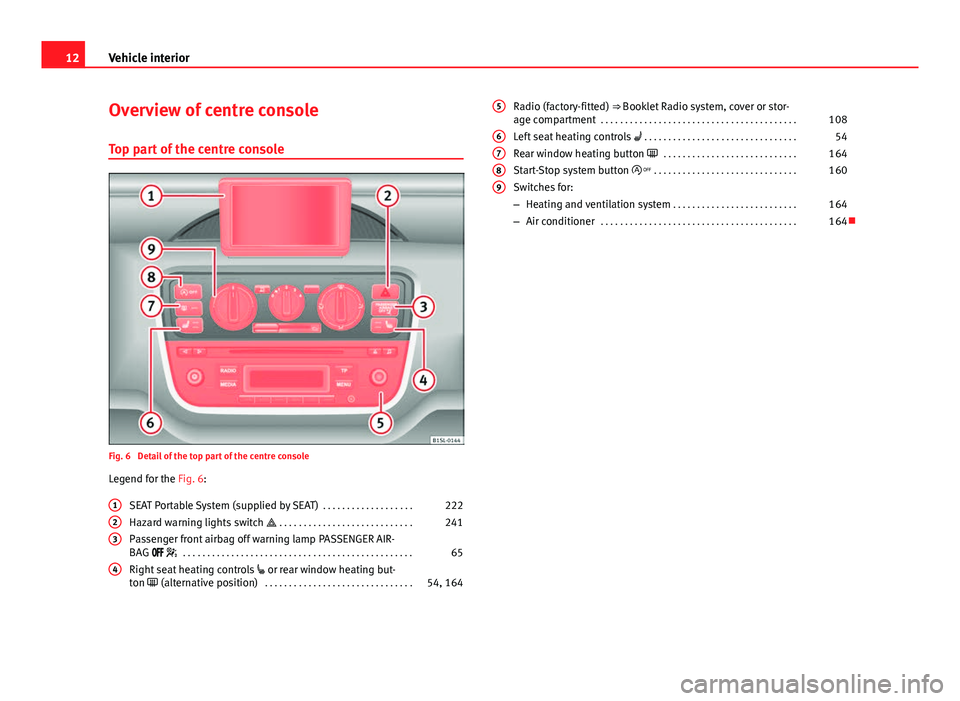
12Vehicle interior
Overview of centre console
Top part of the centre console
Fig. 6 Detail of the top part of the centre console
Legend for the Fig. 6:
SEAT Portable System (supplied by SEAT) . . . . . . . . . . . . . . . . . . .222
Hazard warning lights switch . . . . . . . . . . . . . . . . . . . . . . . . . . . . 241
Passenger front airbag off warning lamp PASSENGER AIR-
BAG . . . . . . . . . . . . . . . . . . . . . . . . . . . . . . . . . . . . . . . . . . . . . . . . 65
Right seat heating controls or rear window heating but-
ton (alternative position) . . . . . . . . . . . . . . . . . . . . . . . . . . . . . . . 54, 164
1
23
4
Radio (factory-fitted) ⇒ Booklet Radio system, cover or stor-
age compartment
. . . . . . . . . . . . . . . . . . . . . . . . . . . . . . . . . . . . . . . . . 108
Left seat heating controls . . . . . . . . . . . . . . . . . . . . . . . . . . . . . . . . 54
Rear window heating button . . . . . . . . . . . . . . . . . . . . . . . . . . . . 164
Start-Stop system button . . . . . . . . . . . . . . . . . . . . . . . . . . . . . . 160
Switches for:
– Heating and ventilation system . . . . . . . . . . . . . . . . . . . . . . . . . . 164
– Air conditioner . . . . . . . . . . . . . . . . . . . . . . . . . . . . . . . . . . . . . . . . . 1645
6789
Page 28 of 306

26Before starting the engine
Check list (Continued)
Correctly fasten your seat belt before starting to drive and keep it se-
curely fastened throughout the journey. This applies to all
passengers in the vehicle
⇒ page 56.
Never carry more passengers than the number of available seats and
seat belts in your vehicle.
Never drive with impaired faculties (for example, due to medication,
alcohol or drugs).
Do not allow yourself to be distracted from the traffic, for example, to
reset or switch on a menu, by other passengers or to answer a phone
call.
Always try to adapt the speed of the vehicle and your style of driving
to the condition of the ground or the road and to weather and traffic
conditions.
Observe the highway code and speed limits.
On long journeys, rest at regular intervals (at least every 2 hours).
If carrying animals, make sure they are correctly restrained in accord-
ance with their weight and size.
WARNING
Always observe traffic regulations and speed limits and try to anticipate
traffic movements. Correctly anticipating traffic situations may mean the
difference between arriving safe and sound at your destination or having
a serious accident.
Note
Regular servicing of your vehicle not only helps to keep it in good working
order but also helps to ensure road safety. Therefore, please ensure the ve-
hicle is taken for service as indicated in the Maintenance Programme. If the
vehicle is subjected to hard use, it may require certain maintenance work
before the next service date. Hard use may involve frequent driving in traffic
jams or driving in dusty areas. For further information, please refer to a SEAT
dealership or a specialised workshop.
Driving abroad
Check list
In some countries, certain safety regulations and requirements are in force
relating to exhaust gas emissions, which differ from the technical character-
istics of the vehicle. Before travelling abroad, SEAT recommends you con-
sult a SEAT dealership about the legal requirements and the following
points:
Does the vehicle need technical modifications for driving abroad, for
example, adjustment of the headlamps?
Does the vehicle have all the tools, diagnostics equipment and
spare parts required for inspections and repairs?
Are there any SEAT dealers in the destination country?
For petrol vehicles: Is unleaded petrol available at the right octane
rating?
Are a suitable engine oil (
⇒ page 185) and other engine fluids com-
plying with SEAT specifications available in the destination country?
Does the Portable Navigation System (supplied by SEAT) function
⇒
page 222 in the destination country with the available navigation
information?
Are special tyres required in the destination country?
Page 58 of 306

56Ensuring you are correctly and safely seated
Seat belts
Introduction
Check the condition of all the seat belts at regular intervals. If you notice
that the belt webbing, fittings, retractor mechanism or buckle of any of the
belts is damaged, the belt must be replaced immediately by a specialised
workshop ⇒
. The specialised workshop must use the appropriate spare
parts corresponding to the vehicle, the equipment and the model year. SEAT
recommends visiting a Technical Service.
Additional information and warnings:
● Adjust the seat position ⇒ page 47
● Airbag system ⇒ page 65
● Child seats (accessories) ⇒ page 74
● Accessories, parts replacement, repairs and modifications ⇒ page 222
WARNING
Unbuckled or badly buckled seat belts increase the risk of severe or even
fatal injuries. The seat belt cannot offer its full protection if it is not fas-
tened and used correctly.
● Seats belts are the most effective ways of reducing the risk of sus-
taining severe or fatal injuries In the event of an accident. Seat belts
must be correctly fastened when the vehicle is in motion to protect the
driver and all vehicle occupants.
● Before each trip, every occupant in the vehicle occupants must sit
properly, correctly fasten the seat belt belonging to his or her seat and
keep it fastened throughout the trip. This also applies to other vehicle
occupants when driving in town.
WARNING (Continued)
● When travelling, children must be secured in the vehicle with a child
restraint system suitable for their weight and height and with the seat
belts correctly fastened ⇒ page 74.
● Instruct your passengers to fasten their seat belts properly before
driving off.
● Insert the latch plate into the buckle for the appropriate seat and en-
sure it is engaged. Using the latch plate in the buckle of another seat will
not protect you properly and may cause severe injuries.
● Do not allow liquids or foreign bodies to enter the buckle fastenings.
This could damage the buckles and seat belts.
● Never unbuckle your seat belt when the vehicle is moving.
● Never allow more than one passenger to share the same seat belt.
● Never hold children or babies on your lap sharing the same seat belt.
● Loose, bulky clothing (such as a jacket) impairs the proper fit and
function of the seat belt.
WARNING
It is extremely dangerous to drive using damaged seat belts and could re-
sult in serious injury or loss of life.
● Avoid damaging the seat belt by jamming it in the door or the seat
mechanism.
● If the fabric or other parts of the seat belt are damaged, the seat belts
could break in the event of an accident or sudden braking.
● Always have damaged seatbelts replaced immediately by seat belts
approved for the vehicle in question by SEAT. Seat belts which have been
worn in an accident and stretched must be replaced by a specialised
workshop. Renewal may be necessary even if there is no apparent dam-
age. The belt anchorage should also be checked.
● Never attempt to repair, modify or remove a seat belt yourself. All re-
pairs to seat belts, retractors and buckles must be carried out by a speci-
alised workshop.
Page 62 of 306
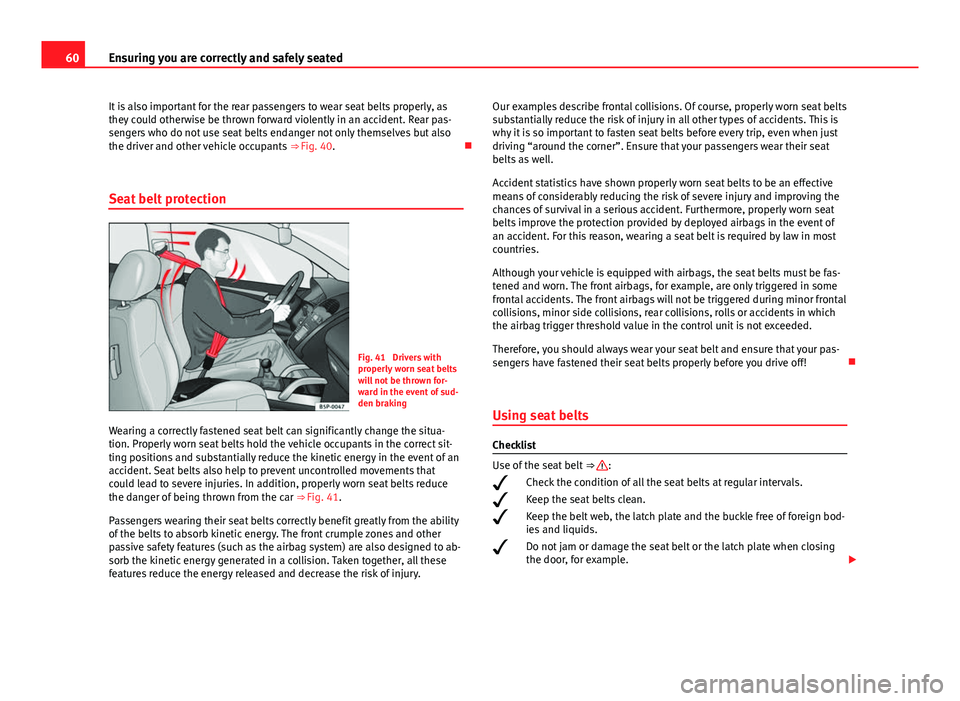
60Ensuring you are correctly and safely seated
It is also important for the rear passengers to wear seat belts properly, as
they could otherwise be thrown forward violently in an accident. Rear pas-
sengers who do not use seat belts endanger not only themselves but also
the driver and other vehicle occupants ⇒ Fig. 40.
Seat belt protection
Fig. 41 Drivers with
properly worn seat belts
will not be thrown for-
ward in the event of sud-
den braking
Wearing a correctly fastened seat belt can significantly change the situa-
tion. Properly worn seat belts hold the vehicle occupants in the correct sit-
ting positions and substantially reduce the kinetic energy in the event of an
accident. Seat belts also help to prevent uncontrolled movements that
could lead to severe injuries. In addition, properly worn seat belts reduce
the danger of being thrown from the car ⇒ Fig. 41.
Passengers wearing their seat belts correctly benefit greatly from the ability
of the belts to absorb kinetic energy. The front crumple zones and other
passive safety features (such as the airbag system) are also designed to ab-
sorb the kinetic energy generated in a collision. Taken together, all these
features reduce the energy released and decrease the risk of injury. Our examples describe frontal collisions. Of course, properly worn seat belts
substantially reduce the risk of injury in all other types of accidents. This is
why it is so important to fasten seat belts before every trip, even when just
driving “around the corner”. Ensure that your passengers wear their seat
belts as well.
Accident statistics have shown properly worn seat belts to be an effective
means of considerably reducing the risk of severe injury and improving the
chances of survival in a serious accident. Furthermore, properly worn seat
belts improve the protection provided by deployed airbags in the event of
an accident. For this reason, wearing a seat belt is required by law in most
countries.
Although your vehicle is equipped with airbags, the seat belts must be fas-
tened and worn. The front airbags, for example, are only triggered in some
frontal accidents. The front airbags will not be triggered during minor frontal
collisions, minor side collisions, rear collisions, rolls or accidents in which
the airbag trigger threshold value in the control unit is not exceeded.
Therefore, you should always wear your seat belt and ensure that your pas-
sengers have fastened their seat belts properly before you drive off!
Using seat belts
Checklist
Use of the seat belt ⇒
:
Check the condition of all the seat belts at regular intervals.
Keep the seat belts clean.
Keep the belt web, the latch plate and the buckle free of foreign bod-
ies and liquids.
Do not jam or damage the seat belt or the latch plate when closing
the door, for example.
Page 63 of 306
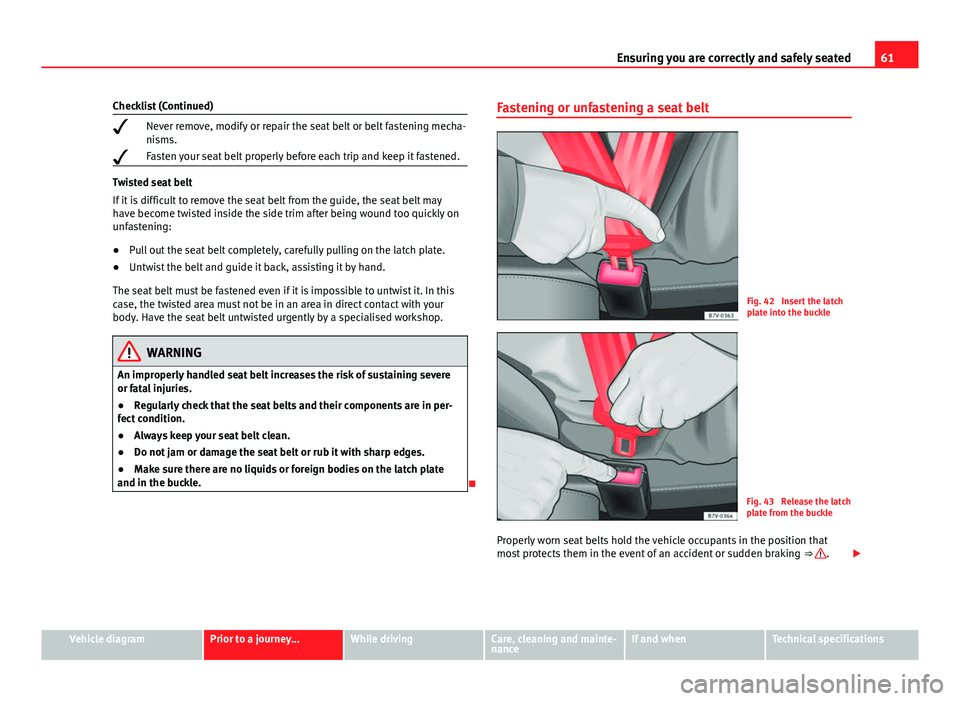
61
Ensuring you are correctly and safely seated
Checklist (Continued)
Never remove, modify or repair the seat belt or belt fastening mecha-
nisms.
Fasten your seat belt properly before each trip and keep it fastened.
Twisted seat belt
If it is difficult to remove the seat belt from the guide, the seat belt may
have become twisted inside the side trim after being wound too quickly on
unfastening:
●
Pull out the seat belt completely, carefully pulling on the latch plate.
● Untwist the belt and guide it back, assisting it by hand.
The seat belt must be fastened even if it is impossible to untwist it. In this
case, the twisted area must not be in an area in direct contact with your
body. Have the seat belt untwisted urgently by a specialised workshop.
WARNING
An improperly handled seat belt increases the risk of sustaining severe
or fatal injuries.
● Regularly check that the seat belts and their components are in per-
fect condition.
● Always keep your seat belt clean.
● Do not jam or damage the seat belt or rub it with sharp edges.
● Make sure there are no liquids or foreign bodies on the latch plate
and in the buckle.
Fastening or unfastening a seat belt
Fig. 42 Insert the latch
plate into the buckle
Fig. 43 Release the latch
plate from the buckle
Properly worn seat belts hold the vehicle occupants in the position that
most protects them in the event of an accident or sudden braking ⇒
.
Vehicle diagramPrior to a journey...While drivingCare, cleaning and mainte-
nanceIf and whenTechnical specifications
Page 91 of 306

89
Lights and visibility
Windscreen wiper and washer
Introduction
Additional information and warnings:
● Exterior detail ⇒ page 6
● Air recirculation mode ⇒ page 164
● Working in the engine compartment ⇒ page 180
● Caring for and cleaning the vehicle exterior ⇒ page 197
WARNING
Water from the windscreen washer water bottle may freeze on the wind-
screen if it does not contain enough anti-freeze, reducing forward visibili-
ty.
● In winter, ensure the windscreen washer contains enough anti-freeze.
● In cold conditions, you should not use the wash/wipe system unless
you have warmed the windscreen with the ventilation system. The anti-
freeze could freeze on the windscreen and reduce visibility.
WARNING
Worn or dirty wiper blades reduce visibility and increase the risk of acci-
dent and serious injury.
● Always replace damaged or worn blades or blades which do not clean
the windscreen correctly.
CAUTION
In icy conditions, always check that the wiper blades are not frozen to the
glass before using the wipers for the first time. In cold weather, it may help
to leave the vehicle parked with the wipers in service position ⇒ page 91. Window wiper lever
Fig. 60 Using the wind-
screen wipers
Fig. 61 Using the rear
window wipers
Vehicle diagramPrior to a journey...While drivingCare, cleaning and mainte-
nanceIf and whenTechnical specifications
Page 97 of 306
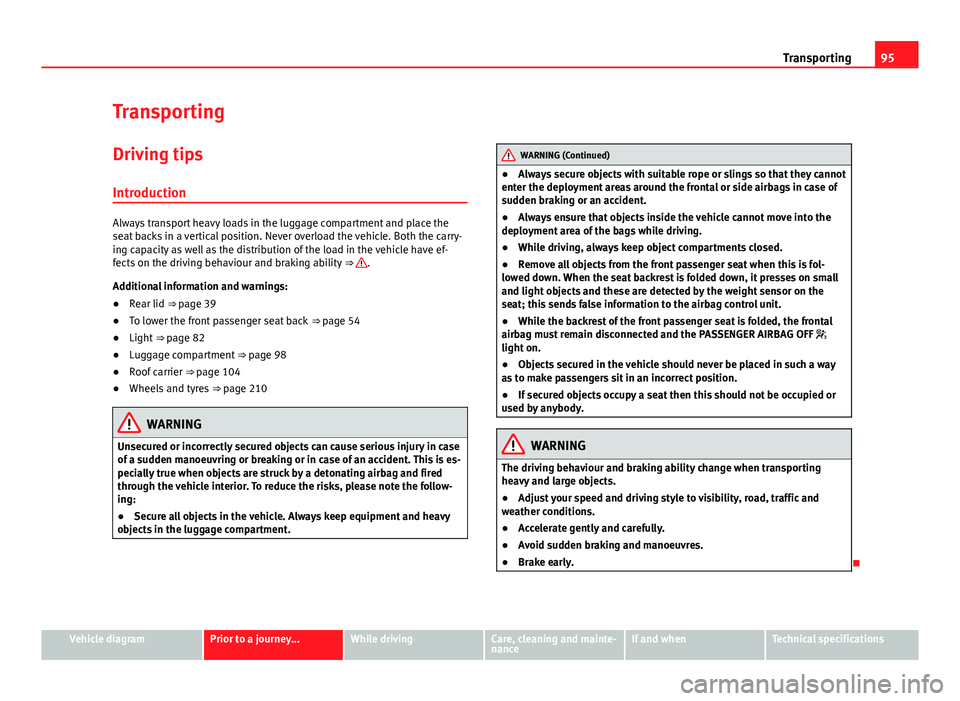
95
Transporting
Transporting
Driving tips Introduction
Always transport heavy loads in the luggage compartment and place the
seat backs in a vertical position. Never overload the vehicle. Both the carry-
ing capacity as well as the distribution of the load in the vehicle have ef-
fects on the driving behaviour and braking ability ⇒
.
Additional information and warnings:
● Rear lid ⇒ page 39
● To lower the front passenger seat back ⇒ page 54
● Light ⇒ page 82
● Luggage compartment ⇒ page 98
● Roof carrier ⇒ page 104
● Wheels and tyres ⇒ page 210
WARNING
Unsecured or incorrectly secured objects can cause serious injury in case
of a sudden manoeuvring or breaking or in case of an accident. This is es-
pecially true when objects are struck by a detonating airbag and fired
through the vehicle interior. To reduce the risks, please note the follow-
ing:
● Secure all objects in the vehicle. Always keep equipment and heavy
objects in the luggage compartment.
WARNING (Continued)
● Always secure objects with suitable rope or slings so that they cannot
enter the deployment areas around the frontal or side airbags in case of
sudden braking or an accident.
● Always ensure that objects inside the vehicle cannot move into the
deployment area of the bags while driving.
● While driving, always keep object compartments closed.
● Remove all objects from the front passenger seat when this is fol-
lowed down. When the seat backrest is folded down, it presses on small
and light objects and these are detected by the weight sensor on the
seat; this sends false information to the airbag control unit.
● While the backrest of the front passenger seat is folded, the frontal
airbag must remain disconnected and the PASSENGER AIRBAG OFF
light on.
● Objects secured in the vehicle should never be placed in such a way
as to make passengers sit in an incorrect position.
● If secured objects occupy a seat then this should not be occupied or
used by anybody.
WARNING
The driving behaviour and braking ability change when transporting
heavy and large objects.
● Adjust your speed and driving style to visibility, road, traffic and
weather conditions.
● Accelerate gently and carefully.
● Avoid sudden braking and manoeuvres.
● Brake early.
Vehicle diagramPrior to a journey...While drivingCare, cleaning and mainte-
nanceIf and whenTechnical specifications
Page 106 of 306
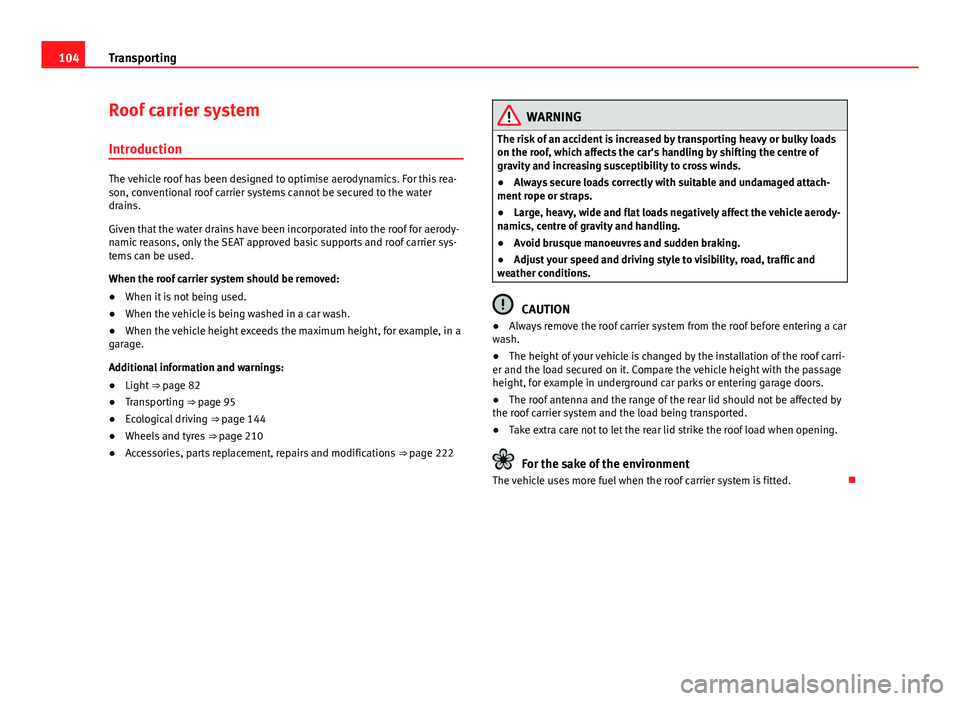
104Transporting
Roof carrier system
Introduction
The vehicle roof has been designed to optimise aerodynamics. For this rea-
son, conventional roof carrier systems cannot be secured to the water
drains.
Given that the water drains have been incorporated into the roof for aerody-
namic reasons, only the SEAT approved basic supports and roof carrier sys-
tems can be used.
When the roof carrier system should be removed:
● When it is not being used.
● When the vehicle is being washed in a car wash.
● When the vehicle height exceeds the maximum height, for example, in a
garage.
Additional information and warnings:
● Light ⇒ page 82
● Transporting ⇒ page 95
● Ecological driving ⇒ page 144
● Wheels and tyres ⇒ page 210
● Accessories, parts replacement, repairs and modifications ⇒ page 222
WARNING
The risk of an accident is increased by transporting heavy or bulky loads
on the roof, which affects the car's handling by shifting the centre of
gravity and increasing susceptibility to cross winds.
● Always secure loads correctly with suitable and undamaged attach-
ment rope or straps.
● Large, heavy, wide and flat loads negatively affect the vehicle aerody-
namics, centre of gravity and handling.
● Avoid brusque manoeuvres and sudden braking.
● Adjust your speed and driving style to visibility, road, traffic and
weather conditions.
CAUTION
● Always remove the roof carrier system from the roof before entering a car
wash.
● The height of your vehicle is changed by the installation of the roof carri-
er and the load secured on it. Compare the vehicle height with the passage
height, for example in underground car parks or entering garage doors.
● The roof antenna and the range of the rear lid should not be affected by
the roof carrier system and the load being transported.
● Take extra care not to let the rear lid strike the roof load when opening.
For the sake of the environment
The vehicle uses more fuel when the roof carrier system is fitted.
Page 140 of 306

138Starting, changing gears, parking
A layer of salt on the discs and brake pads will reduce the effectiveness of
the brakes and increase braking distance. If you drive for a prolonged peri-
od on salted roads without braking then brake carefully several times to
eliminate the layer of salt on the brakes ⇒
.
If the vehicle remains parked for considerable lengths of time, is used little,
or if the brakes are not used, there may be corrosion on the brake discs and
a build up of dirt on the brake pads. If the brakes are not used frequently, or
if rust has formed on the discs, SEAT recommends cleaning the pads and
discs by braking firmly a few times at a moderately high speed. Only do this
without endangering vehicles behind you or any other road users ⇒
.
Faults in the brake system
During braking, if you notice that the vehicle does not react as usual (that
the braking distance has increased suddenly) it may be possible that there
is a fault in the braking system. This is indicated by the warning lamp .
Take the vehicle to a specialised workshop immediately and have the fault
repaired. Drive at a moderate speed and be prepared to use more pressure
on the brake pedal, and allow for longer stopping distances.
Brake servo
The brake servo only operates when the engine is running and the pressure
applied by the driver on the brake pedal increases.
If the brake servo does not operate or the vehicle must be towed, then the
brake pedal will have to be pressed with more force given that the braking
distance will be increased when the brake servo does not operate ⇒
.
WARNING
New brake pads do not brake to full efficiency.
● For the first 320 km (200 miles), new brake pads have not yet reached
their maximum braking capacity, and need to be “run in” first. For this, to
compensate for reduced braking efficiency the brake pedal will have to
be pressed with more force.
WARNING (Continued)
● To avoid losing control of the vehicle and causing serious accidents,
always take great care when driving with new brake pads.
● When running in new brake pads, always respect the safety distances
between you and other vehicles and do not cause situations requiring ex-
treme braking performance.
WARNING
When brakes overheat, braking is less efficient and braking distances in-
crease.
● When driving on slopes, brakes can be overloaded and overheat
quickly.
● Reduce speed or reduce the gear when faced with steep and long
slopes. This allows you to use the engine braking effect and to reduce
the strain on the brake system.
● Non-standard or damaged front spoilers could restrict the airflow to
the brakes and cause them to overheat.
WARNING
Wet, frozen or salt-covered brakes take time to brake and this increases
braking distances.
● Test the brakes carefully.
● Dry the brakes, free them of ice and salt by braking gently several
times, when visibility, weather, and road and traffic conditions permit.